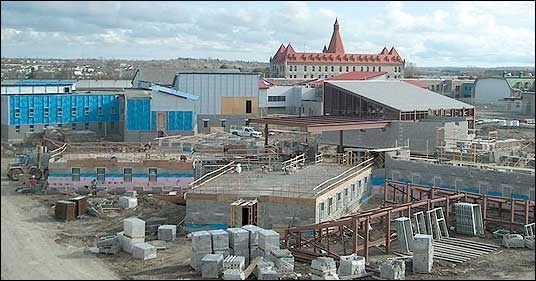Prison repairs behind schedule, plagued by problems
 Federal prison bosses in Ontario are struggling to complete urgent repairs to crumbling penitentiaries, while simultaneously juggling tens of millions of dollars worth of new construction projects, internal Corrections Canada documents obtained by Cancrime reveal (read them after the jump). The records, summaries of the status of major renovation and construction projects underway at prisons across Ontario, reveal that some projects are behind schedule, plagued by cost-overruns and faulty work. In one case, some repairs to the perimeter security wall that encircles Collins Bay Institution in Kingston “have failed and must be re-done.”
Federal prison bosses in Ontario are struggling to complete urgent repairs to crumbling penitentiaries, while simultaneously juggling tens of millions of dollars worth of new construction projects, internal Corrections Canada documents obtained by Cancrime reveal (read them after the jump). The records, summaries of the status of major renovation and construction projects underway at prisons across Ontario, reveal that some projects are behind schedule, plagued by cost-overruns and faulty work. In one case, some repairs to the perimeter security wall that encircles Collins Bay Institution in Kingston “have failed and must be re-done.”

$60 million was spent to build four new cellblocks at medium-security Collins Bay Institution in Kingston. They were completed in 2008. A new 96-bed maximum-security unit is being added to Collins Bay.
The project to repair the “perimeter walls and towers” at Collins Bay, an initiative that includes $2.8 million in planned spending this fiscal year, was supposed to be complete by July 31, 2013, the internal Corrections Canada documents reveal, but the contractor has now submitted a quote for “additional repairs” at a cost of $280,000. The problem, the document states, is “approx 50% of east interior concrete patch repairs have failed and must be re-done.” The contractor is “behind on this year’s schedule,” the document notes. The records obtained by Cancrime are stamped as having been updated on April 25, 2013. It appears that several other major projects are behind schedule. Collins Bay is an 83-year-old medium-security prison. It is one of the federal system’s few penitentiaries still secured by a tall stone wall that encircles the compound, with sentry towers at each corner. Another project at Collins Bay appears to suffer problems. The document notes that renovations at the front entrance of the prison, originally forecast for completion by February 28, 2013, are “substantially complete,” but “the entrance will not be occupied by CSC until there is confidence that the skylight was properly installed and will not leak.” A leaky skylight might not be a critical issue in a shopping plaza, but in a federal prison that houses killers and bank robbers, it could signal shoddy work that poses a security risk. Four new, medium-security cellblocks were completed at Collins Bay in 2008, at a cost of $60 million.
At minimum-security Beaver Creek Institution in Gravenhurst, Ontario, the construction of a new 50-bed unit is behind schedule, the internal documents reveal, citing “delay due to unknown underground water services and communications cables.”
Major repairs are underway across Canada to patch many of the country’s 57 aging and crumbling penitentiaries while new cells are simultaneously being built. In the past several years, the Conservative government and Corrections Canada unveiled plans to add roughly 2,700 new cells to existing penitentiaries. The decision to build the equivalent of five to 10 new prisons by tacking more cellblocks onto existing buildings or plopping them down inside current complexes was a surprising decision. It flew in the face of the key recommendations of a task force that the Harper government commissioned in 2007, at a cost of $3.5 million, to review the operations of the federal prison system and craft a blueprint for renewal. The task force produced a detailed report that called on Corrections to stop the endless renovating and patching and erect new regional prison complexes. The task force found that:
…most penitentiaries are many years past their life cycle and infrastructure replacement has been chronically under funded for a number of years and in particular over the past decade.
Years of renos were causing more problems, the task force concluded.
…the continued tinkering with existing infrastructure within the confined space of existing facilities often unintentionally creates other issues or concerns.
The task force, headed by former Ontario corrections minister Rob Sampson, recommended that until new facilities could be built, Corrections Canada should set rules to “minimize authorization of retrofit projects.” Instead, the Conservative government embarked on the biggest retrofit campaign in the federal system’s history. Since the Conservatives came to power in 2006, spending on prisons has skyrocketed, hitting $2.375 billion by fiscal 2010-11, up a whopping 44% since the 2005-06 fiscal year. New cells are needed to house a growing inmate population, the product of Tory “tough-on-crime” policies that will put more people behind bars for longer sentences, without any evidence that the measures will make communities safer. According to CSC’s last quarterly financial report, the prison service expected to spend nearly $3 billion by the end of the 2012-13 fiscal year, on March 31.
The Harper government trumpeted the Sampson panel as a critical, independent review that was “part of the government’s commitment to protecting Canadian families and communities.” The government’s decision to continue patching and renovating existing prisons bypasses the need for public consultation that likely would be necessary if new prisons were planned for properties not controlled by Ottawa.
The internal documents obtained by Cancrime also show that $6.9 million is expected to be spent this year on construction of a new, 96-bed maximum-security living unit at Millhaven Institution, just west of Kingston. The document does not indicate the progress of the project, but prison sources tell me that the work is behind schedule. Corrections bosses are scrambling to find places for high-security, high-needs convicts, particularly since maximum-security Kingston Penitentiary is slated to close this year.

Public Safety Minister Vic Toews
The government and Corrections did not explain, when the mammoth expansion plans were first announced, that maximum-security cellblocks would be built at medium-security prison complexes, like Collins Bay, where $19 million is being spent to add a 96-bed maximum-security building. Putting maximum-security convicts inside a medium-security compound will present a host of challenges including the need to ensure that the maximum- and medium-security prisoners have no opportunity to interact. This decision suggests that the long-range prison plan is to create regional complexes through a convoluted process of renovation and retrofit (my 2011 story about this issue).
The internal documents indicate that construction also is underway on: a new 96-bed medium-security unit at Fenbrook Institution, a medium-security prison in Gravenhurst; a 50-bed unit at minimum-security Pittsburgh Institution just north of Kingston; a new 50-bed unit at minimum-security Frontenac Institution in Kingston; a new medium-security unit at medium-security Bath Institution, west of Kingston. When Public Safety Minister Vic Toews announced Kingston-area projects in 2010, he indicated that two 96-bed units would be added at Bath, a prison that the union representing guards has long complained is insecure. It was built as a minimum-security prison and later converted for use as a medium-security facility. Toews said the new cells at Millhaven, Collins Bay and Bath institutions would be completed in 2013-14.
During the October 2010 announcement,Toews defended the decision to renovate existing facilities rather than build new prisons.
“We take advice from all kinds of people and we sometimes accept that advice and sometimes we don’t,” Toews said. “In this particular situation, what we have said is that there is capacity in these facilities, there’s an existing infrastructure and therefore the units that we are building, the new units, are consistent with programming or other infrastructure available here.”
Despite claims by Conservatives that the government’s tough-on-crime policies aren’t filling prisons, stats compiled by the office of Canada’s independent penitentiary watchdog, the Office of the Correctional Investigator, show that Canada’s inmate population is ballooning at a rate of roughly 500 additional prisoners yearly, enough to fill one to two new penitentiaries. The prison population grew by nearly 7% in the two-year span from March 2010 to March 2012, from 14,027 to 14,983, according to the correctional investigator. Most worrisome, the report notes, is the dramatic increase in double bunking, the practice in which two prisoners are forced to live in a cell designed for one person. Double bunking increased by a third in one year, between March 2011 and April 2012. Prison guards, inmates rights advocates and researchers warn that increased double bunking will breed tension, violence and bitter parolees. The use of double bunking is surging because the government can’t build new cells fast enough.
Here are the internal Corrections Canada documents obtained by Cancrime that outline the status of construction projects in Ontario:
On a mobile device? Click here to read document.
Note: Prison abbreviations in the document:
MI: Millhaven Institution
BI: Bath Institution
FI: Frontenac Institution
CBI: Collins Bay Institution
FBI: Fenbrook Institution
BCI: Beaver Creek Institution
JI: Joyceville Institution
PI: Pittsburgh Institution
WI: Warkworth Institution
Cancrime
- Rob Tripp's profile
- 8 followers




